
Hey y’all! Thanks so much for stopping by. My name is Laura and I am an Elementary School Counselor turned Curriculum Writer. At my precious school in Nashville, TN, 97% of my students were living in …

Into your office stomps an obviously upset fourth grader: his fists are clenched, his face is as red as his shirt, and his body is trembling.
What do you say? Here are some ideas for you.

Behavior is communication, and it’s not uncommon for kids who have trouble handling emotions to lose control.
Just like adults, kids experience big emotions as they navigate through life, one of the strongest of which is anger. Anger is one of our most basic emotions and although it is often seen as a negative feeling, it does serve a purpose. Anger signals to our body and mind that something is wrong, and that we need to either protect ourselves or fix it.
Children often have underlying emotions that can be masked as anger. More vulnerable emotions such as anxiety, guilt, loneliness, powerlessness, confusion, or helplessness may lie beneath their angry outbursts. An “angry” child may actually just be hungry or tired. Or they may have recently lost a loved one and express their grief as anger. By learning the child’s story, familiarizing ourselves with their behavior patterns, and communicating with parents and teachers, we can unmask the child’s anger.
To help children manage anger, I like to use the three-step model outlined below. In this post, I’ll walk you through my process and review helpful resources along the way.

The first step in helping children cope with anger is to teach them to recognize the physiological signs of anger in their bodies. By listening to our bodies and building this sense of self-awareness, we can tackle our feelings before we flip our lid. Physical signs such as furrowed eyebrows, sweating, clenched jaw, red cheeks, racing heart, and short breaths are common symptoms of anger. To make this concept more relatable for children, I like to use visuals such as the image below and ask them to circle which physiological signs of anger they have noticed in their own bodies.

It is also important to teach children that anger is not a black or white issue. We are not just angry or calm with no feelings in between. Anger exists on a continuum that ranges from “calm” to “rage,” and most of the time we experience anger somewhere in between these two extremes.
I like to use kid-friendly anger scales such as the one in the image below to help children rate their anger on a scale from 1 to 5. Anger scales also help children understand the need to pay attention to our bodies when we hit a “2” or “3” on the scale. This way, we can intervene with coping strategies and start to work our way back down to a “1.”
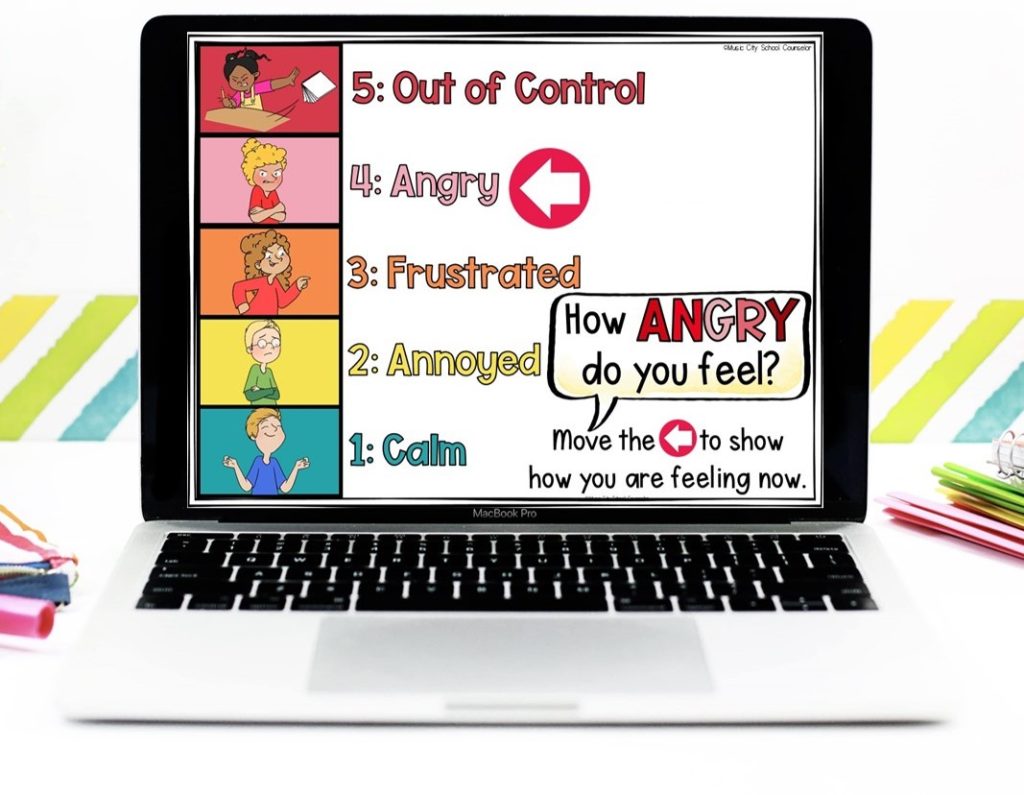
Once children understand how they experience anger and can identify and rate their feelings, they can learn to name their feelings. I teach students to say, “I am feeling angry” rather than “I am angry” so that they remember that they are more than their emotion…and their feeling is only temporary. The quote from Mooji: “Feelings are just visitors. Let them come and go.” helps children understand that they may feel angry, sad, or hurt now, but with time and coping skills, these feelings will soon be on their way. Naming and accepting our feelings as our temporary, but real truth in this moment, is the first step to moving forward.
The next (crucial!) step to working through anger with children is to identify their anger triggers. Knowing our triggers, and noticing those first physiological signs of anger in our body, can help prevent an outburst. Triggers vary greatly from person to person, and keep in mind that situations that seem minute to an adult, such as skipping in line or not sharing a crayon, can be the center of a child’s universe. Common anger triggers for children include being emotionally or physically hurt, perceiving something as unfair, violation of their personal space, and a lack of control.
To help children identify the most frequent sources of their anger, I like to explore with them different examples of common anger triggers. This Digital Anger Activity lets students read through different scenarios and drag that ones that upset them the most to the notepad.
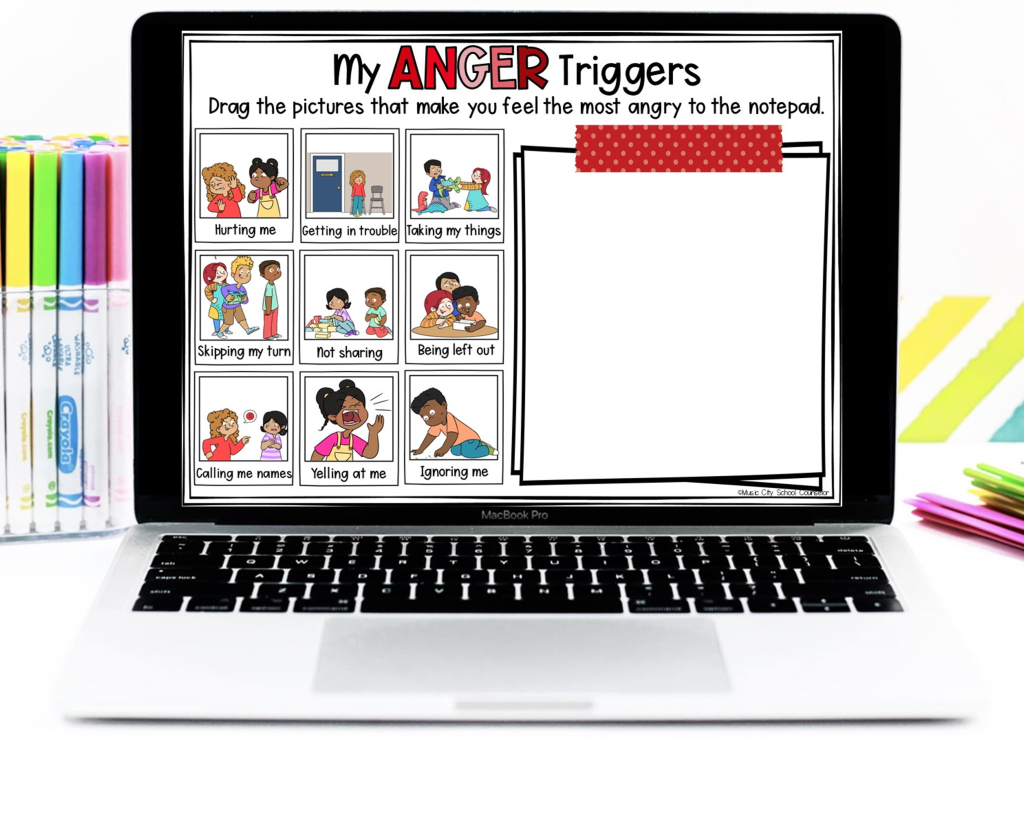
This printable Anger Triggers & Calm Down Strategies activity is also super effective for helping children identify their triggers and cope with anger. After exploring the included 24 anger trigger cards, children create a reference sheet with their 6 most common triggers. Students, parents and teachers love the inside look and insight this activity offers at the students’ feelings.
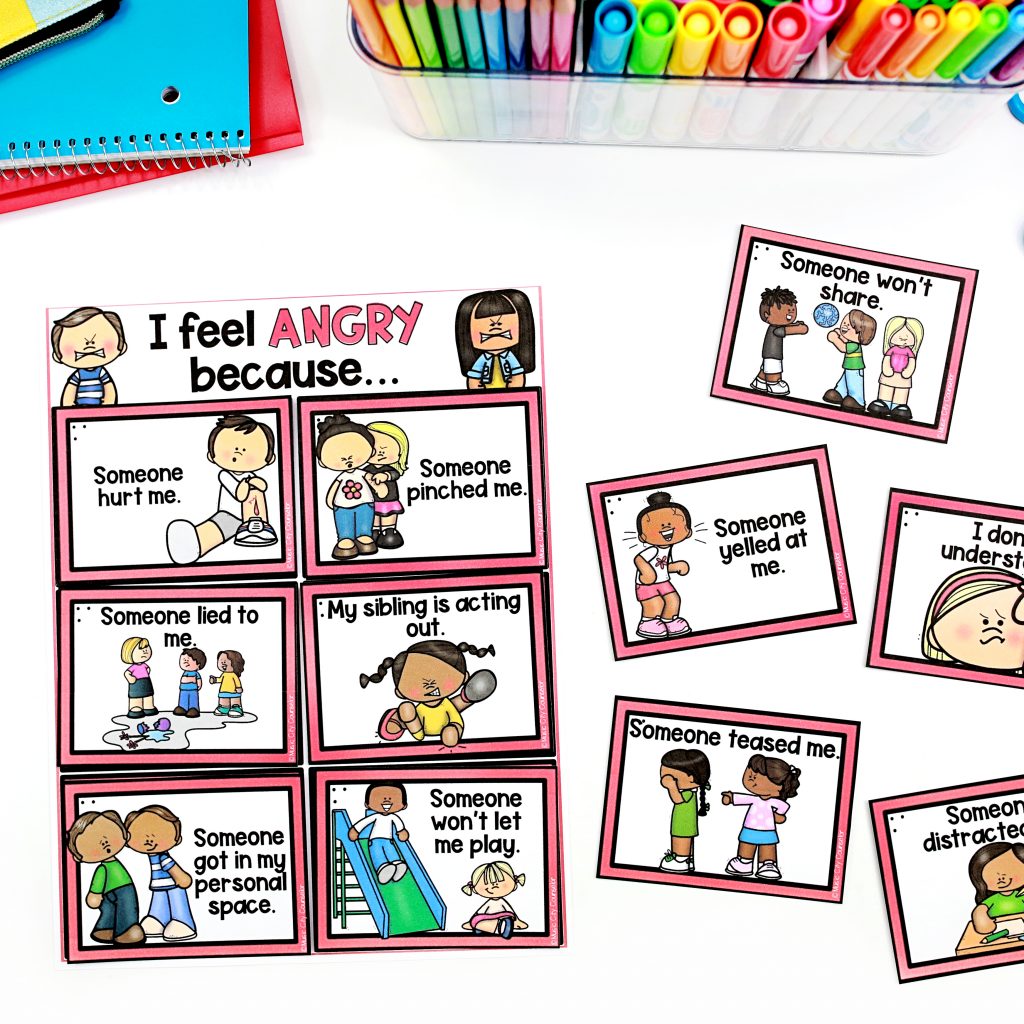
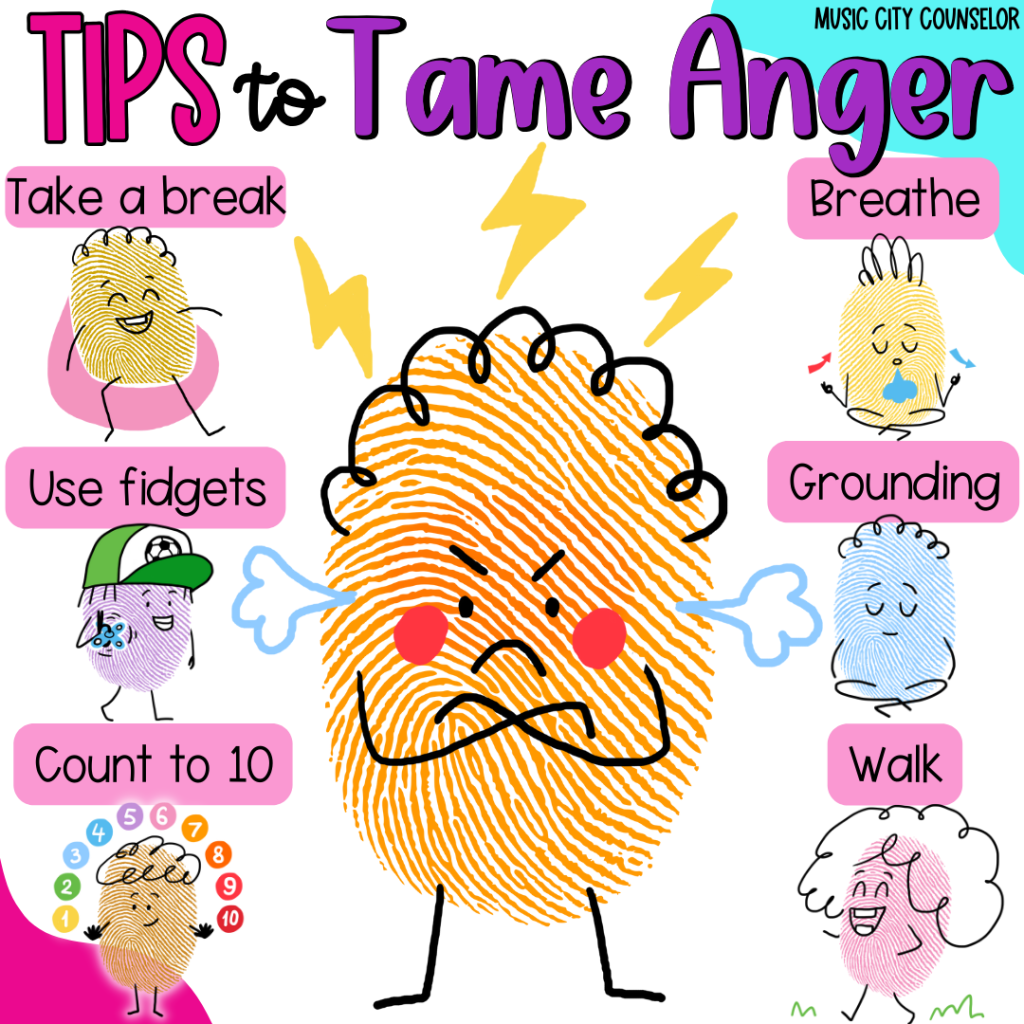
The final, critical step to helping a child manage their anger is to teach, model, and practice coping strategies. I always make sure to start by normalizing anger with the child as a natural feeling that we all experience. I also explain that although anger is a normal feeling, it can be a dangerous one that can lead us to make unsafe and unkind choices if we don’t learn to tame it.
There are numerous options for calm down strategies that we can teach, and children have different preferences and levels of success with different coping skills.
The first coping skill that I always teach, since it is one of the easiest to do but the most effective, is to stop, breathe, and count to 10. This moment of pause can reset our brains and bodies and prevent us from making a quick, emotional reaction that we may regret.
I like to teach “candle breathing” to my elementary learners that asks them to hold up their index finger and pretend it is a yummy-smelling candle. They take a deep breath in through their nose and “smell” their candle, then take a nice, smooth breath out through their mouth and pretend to “blow out” their candle.
To teach other helpful calm down strategies, I use the same digital and printable activities that I referenced above. In this Digital Anger Activity, children learn 9 helpful calm down strategies and drag the ones that they would most like to practice and use to the notepad.

In my printable Anger Triggers & Calm Down Strategies activity, children explore and practice 20 helpful coping skills. They choose the 6 strategies that they would most like to continue using and attach them to the reference sheet with hook-and-loop fastener dots or glue.
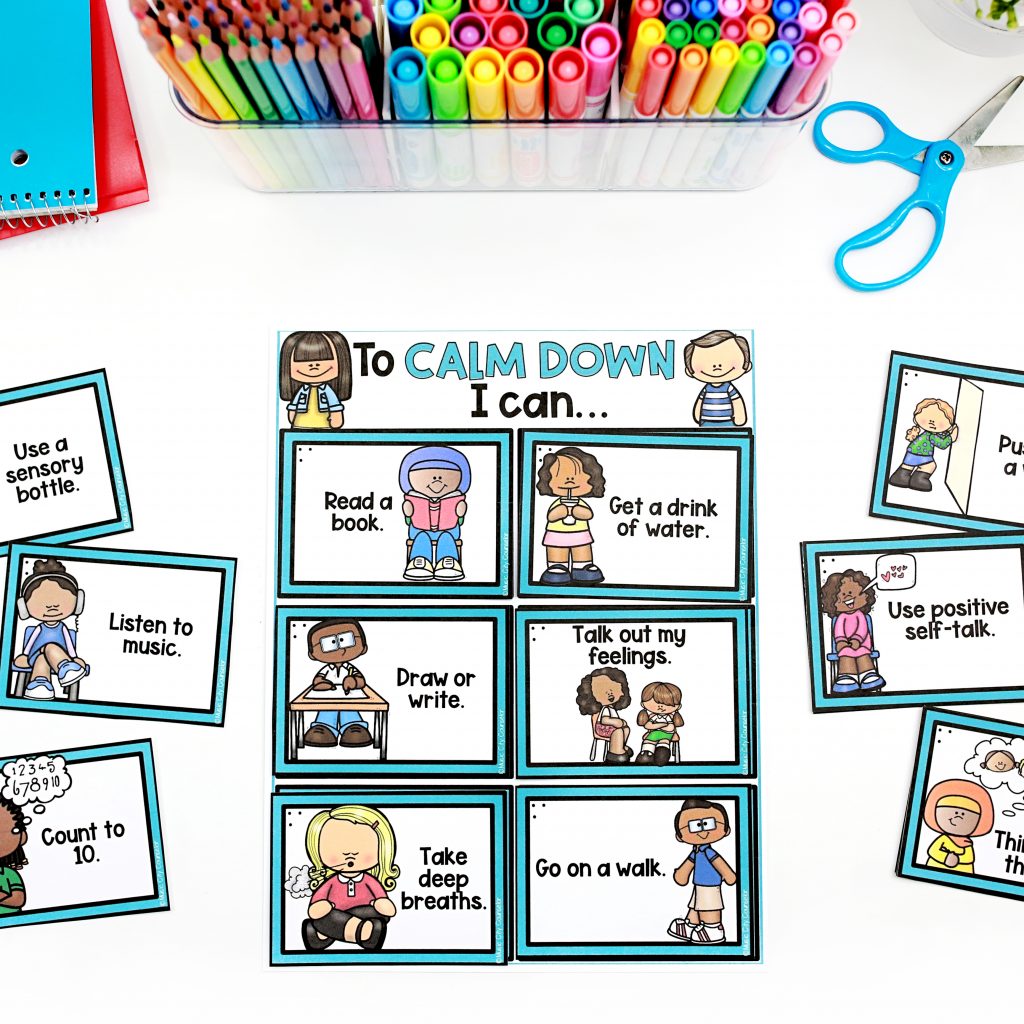
To offer in-the-moment support for children who are feeling angry, frustrated, or upset, I love to use this interactive activity included in my printable anger resource. I keep it on a clipboard and use hook-and-loop fastener dots so that it can be used over and over again. Students look through the anger trigger cards and choose the 2 that best describe why they are feeling upset in this moment. Then, they select 2 calm down strategies that they would like to try. After using the coping skills, they ask themselves if they are calm and choose either the thumbs up or the thumbs down. If they feel calm enough to return to the group, they can do so, or if they need more time, they can try the same coping skills again or choose 2 different ones to try. Students repeat this process until they are in control of their feelings and ready to rejoin their class.
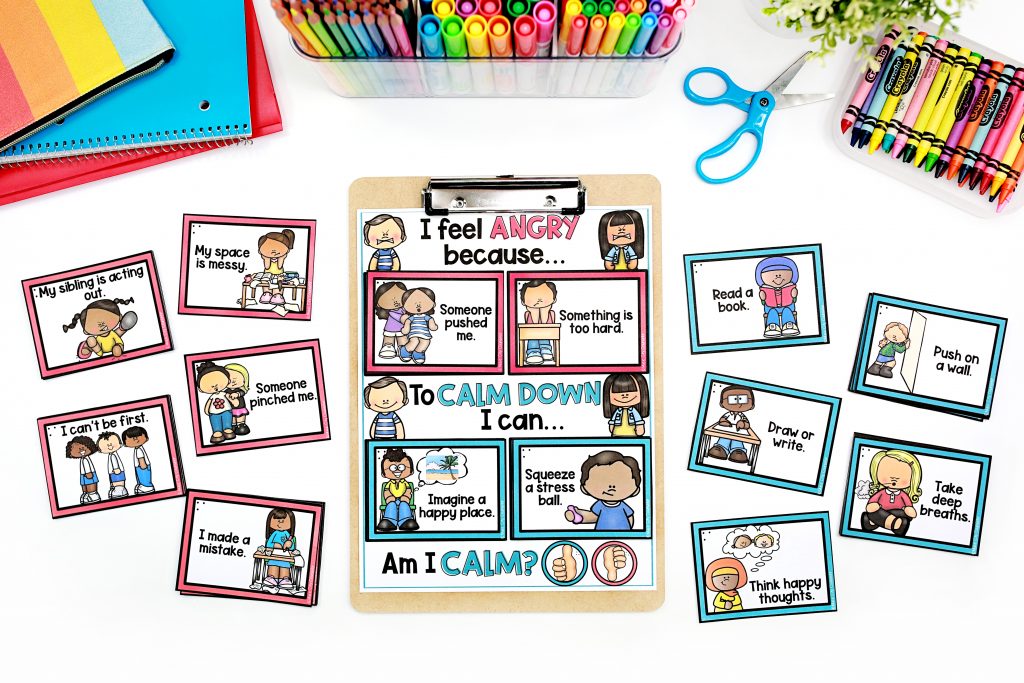
I hope that my 3-step process to teaching children to cope with anger is helpful to you and your students! What are your students’ most common anger triggers, and favorite coping skills? Please comment below, I’d love to hear from you!
You may be interested in:

| Cookie | Duration | Description |
|---|---|---|
| cookielawinfo-checkbox-analytics | 11 months | This cookie is set by GDPR Cookie Consent plugin. The cookie is used to store the user consent for the cookies in the category "Analytics". |
| cookielawinfo-checkbox-functional | 11 months | The cookie is set by GDPR cookie consent to record the user consent for the cookies in the category "Functional". |
| cookielawinfo-checkbox-necessary | 11 months | This cookie is set by GDPR Cookie Consent plugin. The cookies is used to store the user consent for the cookies in the category "Necessary". |
| cookielawinfo-checkbox-others | 11 months | This cookie is set by GDPR Cookie Consent plugin. The cookie is used to store the user consent for the cookies in the category "Other. |
| cookielawinfo-checkbox-performance | 11 months | This cookie is set by GDPR Cookie Consent plugin. The cookie is used to store the user consent for the cookies in the category "Performance". |
| viewed_cookie_policy | 11 months | The cookie is set by the GDPR Cookie Consent plugin and is used to store whether or not user has consented to the use of cookies. It does not store any personal data. |
One Response
I can’t express how much I appreciate all the strategies and information you share!!!